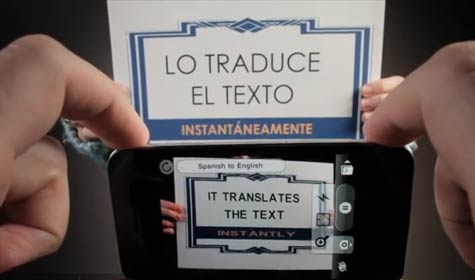Great progress is being made in the world of translation apps. ExtremeTech reports that a new version of Microsoft’s Skype Translator can translate on the fly. The story says that it “has a long way to go before it’s ready for prime time” but that the preview shows that the company is headed in the right direction:
While it can translate instant messages in any of over 40 languages, this early build can only translate voice chat in Spanish and English. On top of that, this preview program only works on Windows 8.x and the Windows 10 Technical Preview, so Skype fans on other platforms are currently left out in the cold. Thankfully, that’s bound to change when this feature is fully baked.
In essence, Skype uses Microsoft’s neural network to translate the words to text. The words are then put through a Bing-based translation engine and a text-to-speech engine delivers the translated words.
Another interesting and undoubtedly useful translation app is available from Google, which bought the developer of the Word Lens app in May. The app translates what a phone sees through its camera lens and shows it on the display, according to Android Police.
A demo at Google Play shows the system in action. The Android Police story says that the initial rollout of Live Translate will translate both ways between English and French, German, Italian, Portuguese, Russian and Spanish. The system also offers functionality much like Microsoft Skype Translator.
In a multinational, multicultural world, language apps will be a hot item. And it isn’t only the big companies that excel at creating useful apps. How We Made It In Africa offers an interview with Glenn Stein, a young entrepreneur who created Aweza, an iOS and Android app that translates phrases into the 11 official South African languages. The bottom line is that Stein has big plans, but also faces significant challenges due to the size of the venture.
While translation apps are good and improving, BizCommunity’s Ian Henderson points out that they go so far, but not far enough to replace actual translators:
The fact is that these mobile apps are made for consumers and not for businesses that need to help customers use their products. If you’re localising a product for a new market, the documentation has to be translated into that country’s language. Relying on automatic technology to translate something complex like a manual for assembly-line heating equipment or a software analytics user interface can lead to a frustrating experience at best, and a lethal experience at worst.
The bottom line is that the new apps are exciting and helpful, but the sophistication necessary for business deals or consumer sales requires the human touch.
Carl Weinschenk covers telecom for IT Business Edge. He writes about wireless technology, disaster recovery/business continuity, cellular services, the Internet of Things, machine-to-machine communications and other emerging technologies and platforms. He also covers net neutrality and related regulatory issues. Weinschenk has written about the phone companies, cable operators and related companies for decades and is senior editor of Broadband Technology Report. He can be reached at [email protected] and via twitter at @DailyMusicBrk.




